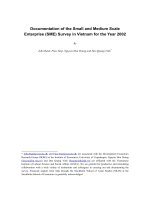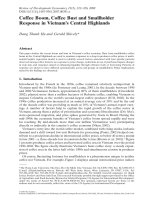Understanding Entrepreneurial Perception and Business Conditions in Vietnam Through the Approach of the Global Entrepreneurship Monitor
Bạn đang xem bản rút gọn của tài liệu. Xem và tải ngay bản đầy đủ của tài liệu tại đây (231.11 KB, 15 trang )
Header Page 1 of 27.
VNU Journal of Science: Economics and Business Vol. 30, No. 2 (2014) 13-27
Understanding Entrepreneurial Perception and Business
Conditions in Vietnam Through the Approach of the Global
Entrepreneurship Monitor
Lương Minh Huân1, Nhâm Phong Tuân2,*
1
Enterprises Development Foundation, Vietnam Chamber of Commerce and Industry (VCCI),
4th Floor, Đào Duy Anh Str., Đống Đa Dist., Hanoi, Vietnam
2
VNU University of Economics and Business,
., Hanoi, Vietnam
Received 11 May 2014
Revised 28 June 2014; Accepted 11 July 2014
Abstract: Based on the survey results of 2,000 individuals and 36 national experts in 2013, and
the analytical framework of the Global Entrepreneurship Monitor (GEM), this paper provides a
broad view of the Vietnamese entrepreneurship characteristics in different phases; from intending
to start, to just starting, to running a new or established business, and even to the discontinuance of
a business. The paper also suggests an analytical framework condition for business development in
Vietnam. Key overall findings show that the perception of the existence of opportunities and
business skills in Vietnam is low. The intention of starting a business in the next three years is
lower than the average ratio of 44.7 percent in other economies. The percentage of surveyed adults
in Vietnam who owned and managed business activities in the early stages has reached 15.4
percent, while the rate of start-up is only 4 percent, which is lower than the average rate in other
economies. The rate of adults who abandoned their business activities in the past 12 months is 4.3
percent, including 2.5 percent of adults who discontinued their business and 1.8 percent of adults
who sold their business for others to operate. Among the total of 12 business condition indicators
in Vietnam, the three following indicators have the highest levels: governmental regulations, the
dynamics of the domestic market, and governmental policies. The three lowest ranking indicators
encompass post-secondary education, secondary education, and business support services. Finally,
this paper proposes recommendations for the improvement of business conditions and the
promotion of the development of entrepreneurial activities in Vietnam in the coming years.
Keywords: GEM, entrepreneurship, business conditions.
1. Introduction and background *
country, the measurement of socio-economic
indicators has become an urgent requirement
for
governments
and
international
organizations. These indicators will help
governments better understand the current
status of their economic development; thus they
can develop appropriate policies in order to
enhance economic development. Currently, the
In the context of globalization and
economic integration today, with the rapid
fluctuations of the economic situation in the
_______
*
Corresponding author. Tel.: 84-963680056
E-mail:
13
Footer Page 1 of 27.
Header Page 2 of 27.
14
L.M. Huân, N.P. Tuân / VNU Journal of Science: Economics and Business Vol. 30, No. 2 (2014) 13-27
World Bank (WB), the World Economic Forum
(WEF), the Organization for Economic
Cooperation and Development (OECD) [1], the
United Nations (UN) and other organizations
through their reports have all taken steps in
promoting and strengthening information about
the indicators of socio-economic development.
One of the necessary socio-economic
indicators is a broad view of the entrepreneurial
characteristics which combine the business
performance index and the business
environment indicator in a country. There is a
wide array of studies on business and
entrepreneurship in the world today. However,
the Global Entrepreneurship Monitor (GEM) is
a research initiative that provides an indicator
for economic growth forecasts. The GEM
measures an individuals’ perception of
entrepreneurial activities, their efforts as well as
their motivation to engage in business activities.
The GEM indicates a number of distinctions
which make it unique compared to other
studies. At the time the GEM was introduced,
no existing initiatives had compared
entrepreneurship across countries, although
there were a number of projects trying to
provide indicators to compare business
development between countries, for example
the COMPENDIA data of OECD. These
indicators, however, reflected a rather single
dimension
of
entrepreneurship
(while
academics agree that entrepreneurship is a
multi-faceted phenomenon), or only covered a
selection of (mainly developed) countries. The
GEM provides an integrated database of
business development situations in a country
that can be compared with the situation of other
countries in the region and in the world.
Although a few similar studies also emerged to
provide a comparative index of national
economic development, including three key
initiatives: the Entrepreneurship Indicators
Program - EIP of the OECD/Kauffman, the
enterprise data/survey of the WB, and the
Footer Page 2 of 27.
survey on entrepreneurship of Eurobarometer,
the GEM remains unique due to the following
characteristics: the GEM combines a business
performance index and a business environment
indicator, and is consistent with the hypothesis
that has been argued by many researchers that
the business environment has a role in leading
business development. The GEM provides not
only research about new or established business
activities, through the adult population survey,
it also focuses on entrepreneurial activities from
the start-up phase to the business growth phase.
This approach provides a detailed view of
business rather than merely numbers found in
any business registration database.
With its importance, the GEM has attracted
nearly 100 countries participating in the
research until 2013. Asia, in particular, has
twenty countries and territories who have
participated in GEM research. In Southeast
Asia, there are five GEM’s members including
Indonesia, Malaysia, the Philippines, Singapore
and Thailand. This suggests the need for
Vietnam to join in and apply GEM
methodology. Therefore, this paper is expected
to apply or follow the approach of GEM
research
to
understand
entrepreneurial
perception and business conditions in Vietnam.
2. Conceptual framework of the GEM
According to the GEM approach, the growth
of a national economy is fully understood as the
result of two factors: current business activities
and entrepreneurial characteristics.
Current business activities may impact
national economic growth mainly through
expansion of business or application of new
technologies, which leads to new job creation
or productivity improvement; thereby it
increases output.
Entrepreneurial
characteristics
impact
directly on entrepreneurship by creating more
Header Page 3 of 27.
L.M. Huân, N.P. Tuân / VNU Journal of Science: Economics and Business Vol. 30, No. 2 (2014) 13-27
jobs and value for society. The decision to start
a business is affected primarily by an
entrepreneur’s attitude, which is referred to as
an ability to recognize and seize opportunities,
an ability to take risks and tackle the fear of
failure, and his/her perception and evaluation of
conditions. Obviously, such an individual who
has the ability to seize opportunities, has a good
business capacity, does not feel failure fear, and
feels social respect for entrepreneurs, is more
likely to start his/her own business than others
in the community. The decision to start a
business will also be governed by his/her daily
activities, life demands or requests by other
people driving him/her to develop an idea of a
new product or a new business plan. Thus, an
individual’s characteristics will influence
his/her decision to start a business.
These two factors have a bi-directional
relationship, thereby requiring simultaneous
consideration of business activities and
individuals who own and manage business
activities as shown in the GEM conceptual
framework (Figure 1). Business activities and
entrepreneurial characteristics are governed by
the general business environment of a country.
Business environment consists of three groups
of elements: basic elements, efficiency
enhancer elements������������������������������������������������������������������������������������������������������������������������������������������������������������������������������������������������������������������������������������������������������������������������������������������������������������������������������������������������������������������������������������������������������������������������������������������������������������������������������������������������������������������������������������������������������������������������������������������������������������������������������������������������������������������������������������������������������������������������������������������������������������������������������������������������������������������������������������������������������������������������������������������������������������������������������������������������������������������������������������������������������������������������������������������������������������������������������������������������������������������������������������������������������������������������������������������������������������������������������������������������������������������������������������������������������������������������������������������������������������������������������������������������������������������������������������������������������������������������������������������������������������������������������������������������������������������������������������������������������������������������������������������������������������������������������������������������������������������������������������������������������������������������������������������������������������������������������������������������������������������������������������������������������������������������������������������������������������������������������������������������������������������������������������������������������������������������������������������������������������������������������������������������������������������������������������������������������������������������������������������������������������������������������������������������������������������������������������������������������������������������������������������������������������������������������������������������������������������������������������������������������������������������������������������������������������������������������������������������������������������������������������������������������������������������������������������������������������������������������������������������������������������������������������������������������������������������������������������������������������������������������������������������������������������������������������������������������������������������������������������������������������������������������������������������������������������������������������������������������������������������������������������������������������������������������������������������������������������������������������������������������������������������������������������������������������������������������������������������������������������������������������������������������������������������������������������������������������������������������������������������������������������������������������������������������������������������������������������������������������������������������������������������������������������������������������������������������������������������������������������������������������������������������������������������������������������������������������������������������������������������������������������������������������������������������������������������������������������������������������������������������������������������������������������������������������������������������������������������������������������������������������������������������������������������������������������������������������������������������������������������������������������������������������������������������������������������������������������������������������������������������������������������������������������������������������������������������������������������������������������������������������������������������������������������������������������������������������������������������������������������������������������������������������������������������������������������������������������������������������������������������������������������������������������������������������������������������������������������������������������������������������������������������������������������������������������������������������������������������������������������������������������������������������������������������������������������������������������������������������������������������������������������������������������������������������������������������������������������������������������������������������������������������������������������������������������������������������������������������������������������������������������������������������������������������������������������������������������������������������������������������������������������������������������������������������������������������������������������������������������������������������������������������������������������������������������������������������������������������������������������������������������������������������������������������������������������������������������������������������������������������������������������������������������������������������������������������������������������������������������������������������������������������������������������������������������������������������������������������������������������������������������������������������������������������������������������������������������������������������������������������������������������������������������������������������������������������������������������������������������������������������������������������������������������������������������������������������������������������������������������������������������������������������������������������������������������������������������������������������������������������������������������������������������������������������������������������������������������������������������������������������������������������������������������������������������������������������������������������������������������������������������������������������������������������������������������������������������������������������������������������������������������������������������������������������������������������������������������������������������������������������������������������������������������������������������������������������������������������������������������������������������������������������������������������������������������������������������������������������������������������������������������������������������������������������������������������������������������������������������������������������������������������������������������������������������������������������������������������������������������������������������������������������������������������������������������������������������������������������������������������������������������������������������������������������������������������������������������������������������������������������������������������������������������������������������������������������������������������������������������������������������������������������������������������������������������������������������������������������������������������������������������������������������������������������������������������������������������������������������������������������������������������������������������������������������������������������������������������������������������������������������������������������������������������������������������������������������������������������������������������������������������������������������������������������������������������������������������������������������������������������������������������������������������������������������������������������������������������������������������������������������������������������������������������������������������������������������������������������������������������������������������������������������������������������������������������������������������������������������������������������������������������������������������������������������������������������������������������������������������������������������������������������������������������������������������������������������������������������������������������������������������������������������������������������������������������������������������������������������������������������������������������������������������������������������������������������������������������������������������������������������������������������������������������������������������������������������������������������������������������������������������������������������������������������������������������������������������������������������������������������������������������������������������������������������������������������������������������������������������������������������������������������������������������������������������������������������������������������������������������������������������������������������������������������������������������������������������������������������������������������������������������������������������������������������������������������������������������������������������������������������������������������������������������������������������������������������������������������������������������������������������������������������������������������������������������������������������������������������������������������������������������������������������������������������������������������������������������������������������������������������������������������������������������������������������������������������������������������������������������������������������������������������������������������������������������������������������������������������������������������������������������������������������������������������������������������������������������������������������������������������������������������������������������������������������������������������������������������������������������������������������������������������������������������������������������������������������������������������������������������������������������������������������������������������������������������������������������������������������������������������������������������������������������������������������������������������������������������������������������������������������������������������������������������������������������������������������������������������������������������������������������������������������������������������������������������������������������������������������������������������������������������������������������������������������������������������������������������������������������������������������������������������������������������������������������������������������������������������������������������������������������������������������������������������������������������������������������������������������������������������������������������������������������������������������������������������������������������������������������������������������������������������������������������������������������������������������������������������������������������������������������������������������������������������������������������������������������������������������������������������������������������������������������������������������������������������������������������������������������������������������������������������������������������������������������������������������������������������������������������������������������������������������������������������������������������������������������������������������������������������������������������������������������������������������������������������������������������������������������������������������������������������������������������������������������������������������������������������������������������������������������������������������������������������������������������������������������������������������������������������������������������������������������������������������������������������������������������������������������������������������������������������������������������������������������������������������������������������������������������������������������������������������������������������������������������������������������������������������������������������������������������������������������������������������������������������������������������������������������������������������������������������������������������������������������������������������������������������������������������������������������������������������������������������������������������������������������������������������������������������������������������������������������������������������������������������������������������������������������������������������������������������������������������������������������������������������������������������������������������������������������������������������������������������������������������������������������������������������������������������������������������������������������������������������������������������������������������������������������������������������������������������������������������������������������������������������������������������������������������������������������������������������������������������������������������������������������������������������������������������������������������������������������������������������������������������������������������������������������������������������������������������������������������������������������������������������������������������������������������������������������������������������������������������������������������������������������������������������������������������������������������������������������������������������������������������������������������������������������������������������������������������������������������������������������������������������������������������������������������������������������������������������������������������������������������������������������������������������������������������������������������������������������������������������������������������������������������������������������������������������������������������������������������������������������������������������������������������������������������������������������������������������������������������������������������������������������������������������������������������������������������������������������������������������������������������������������������������������������������������������������������������������������������������������������������������������������������������������������������������������������������������������������������������������������������������������������������������������������������������������������������������������������������������������������������������������������������������������������������������������������������������������������������������������������������������������������������������������������������������������������������������������������������������������������������������������������������������������������������������������������������������������������������������������������������������������������������������������������������������������������������������������������������������������������������������������������������������������������������������������������������������������������������������������������������������������������������������������������������������������������������������������������������������������������������������������������������������������������������������������������������������������������������������������������������������������������������������������������������������������������������������������������������������������������������������������������������������������������������������������������������������������������������������������������������������������������������������������������������������������������������������������������������������������������������������������������������������������������������������������������������������������������������������������������������������������������������������������������������������������������������������������������������������������������������������������������������������������������������������������������������������������������������������������������������������������������������������������������������������������������������������������������������������������������������������������������������������������������������������������������������������������������������������������������������������������������������������������������������������������������������������������������������������������������������������������������������������������������������������������������������������������������������������������������������������������������������������������������������������������������������������������������������������������������������������������������������������������������������������������������������������������������������������������������������������������������������������������������������������������������������������������������������������������������������������������������������������������������������������������������������������������������������������������������������������������������������������������������������������������������������������������������������������������������������������������������������������������������������������������������������������������������������������������������������������������������������������������������������������������������������������������������������������������������������������������������������������������������������������������������������������������������������������������������������������������������������������������������������������������������������������������������������������������������������������������������������������������������������������������������������������������������������������������������������������������������������������������������������������������������������������������������������������������������������������������������������������������������������������������������������������������������������������������������������������������������������������������������������������������������������������������������������������������������������������������������������������������������������������������������������������������������������������������������������������������������������������������������������������������������������������������������������������������������������������������������������������������������������������������������������������������������������������������������������������������������������������������������������������������������������������������������������������������������������������������������������������������������������������������������������������������������������������������������������������������������������������������������������������������������������������������������������������������������������������������������������������������������������������������������������������������������������������������������������������������������������������������������������������������������������������������������������������������������������������������������������������������������������������������������������������������������������������������������������������������������������������������������������������������������������������������������������������������������������������������������������������������������������������������������������������������������������������������������������������������������������������������������������������������������������������������������������������������������������������������������������������������������������������������������������������������������������������������������������������������������������������������������������������������������������������������������������������������������������������������������������������������������������������������������������������������������������������������������������������������������������������������������������������������������������������������������������������������������������������������������������������������������������������������������������������������������������������������������������������������������������������������������������������������������������������������������������������������������������������������������������������������������������������������������������������������������������������������������������������������������������������������������������������������������������������������������������������������������������������������������������������������������������������������������������������������������������������������������������������������������������������������������������������������������������������������������������������������������������������������������������������������������������������������������������������������������������������������������������������������������������������������������������������������������������������������������������������������������������������������������������������������������������������������������������������������������������������������������������������������������������������������������������������������������������������������������������������������������������������������������������������������������������������������������������������������������������������������������������������������������������������������������������������������������������������������������������������������������������������������������������������������������������������������������������������������������������������������������������������������������������������������������������������������������������������������������������������������������������������������������������������������������������������������������������������������������������������������������������������������������������������������������������������������������������������������������������������������������������������������������������������������������������������������������������������������������������������������������������������������������������������������������������������������������������������������������������������������������������������������������������������������������������������������������������������������������������������������������������������������������������������������������������������������������������������������������������������������������������������������������������������������������������������������������������������������������������������������������������������������������������������������������������������������������������������������������������������������������������������������������������������������������������������������������������������������������������������������������������������������������������������������������������������������������������������������������������������������������������������������������������������������������������������������������������������������������������������������������������������������������������������������������������������������������������������������������������������������������������������������������������������������������������������������������������������������������������������������������������������������������������������������������������������������������������������������������������������������������������������������is quite low, only
2.4 percent, ranking 40th out of 70 countries and
10th out of 13 countries in the first economic
development stage. Compared with the
structure of business sectors of second
development stage countries, the rate of
business activities in the transforming sector
and business oriented services in Vietnam is
much lower. Therefore, in order to keep pace
with, and to switch to, the second stage group,
Vietnam needs to increase the proportions of
these activities.
Networks to support business
In Vietnam, business owners receive tips
and advice mainly from friends and family. For
the business activities at an early stage, nearly
73.8 percent receive advice from friends and
59.7 percent of them get advice from a
husband/wife, 55.3 percent from family
members or relatives and 52.7 percent receive
advice from parents. Business owners of
established entrepreneurial activitiesalso seek
Header Page 11 of 27.
L.M. Huân, N.P. Tuân / VNU Journal of Science: Economics and Business Vol. 30, No. 2 (2014) 13-27
advicefrom these four groups. However, they
rarely receive consultation or advice from
experts or organizations with expertise in
business support such as public consultation for
enterprises, lawyers, accountants, investors,
banks or researchers and inventors. Sources of
adviceavailable to entrepreneurs such as
partners and suppliers are also limited. This
shows that Vietnamese entrepreneurs lack
information sources for consultation relating to
business support services, so they usually seek
advice from their family or friends. Apparently,
there is a lack of consultation services to
support entrepreneurs in Vietnam today.
Business cooperation
During the process of development, each
business activity often works with other
business activities or organizations. This
collaboration can be formal or informal relating
to the production, supply, marketing or business
efficiency. For established business activities in
Vietnam, business cooperation mainly covers
marketing and sales activities, including sales
for existing customers (29.5 percent) and
potential customers (22 percent). Another
activity that can also involve cooperation is
goods production and service provision (24.8
percent). Unfortunately, the process to develop
new products entails the least cooperation,
though this could be the most important step for
the development.
Business discontinuation in Vietnam in
2013
In Vietnam, the rate of adults giving up
their business activities in the last 12 months
is 4.3 percent, with 2.5 percent of the
business activities being stopped and 1.8
percent of business activities being sold to
others to continue operation. These rates in
Vietnamare much lower than the average
level of other countries in the same stage of
development. This result shows that the
stability of business in Vietnam is much
Footer Page 11 of 27.
23
higher than the average level of countries in
the first stage of development, but is lower
than countries in the second and third stage of
development. If compared to the TEA rate,
the rate of business discontinuation in
Vietnam is still high at 27.6 percent. This
means that for every 100 people newly
participating in business activities, 28 other
people will give up their business activities.
Similarly, for every 100 business activities
which are just commenced, 16 other business
activities are subject to discontinuance.
The
main
reasons
for
business
discontinuation, as cited by Vietnamese
entrepreneurs, include not being profitable
(15.3 percent), having financial problems (20
percent) and other personal reasons such as
health or family related issues (35.3 percent).
These are the most common reasons for adults
to give up their business in other economies.
However, there is a slight difference in 2013 in
the rate of people giving up their business
because of unprofitability is the highest in the
surveyed countries, regardless of their level of
economic development. The fourth important
reason in Vietnam, and also in many other
countries, for business discontinuance is that
the people involved have another job or
business opportunity (12.9 percent). The rate of
business discontinuation caused by this reason
in third stage economies is even higher than the
rate of business discontinuation caused by
financial problems. The reason of having
another job or business opportunity along with
the reason that they have an opportunity to sell
their business (accounting for 2.4 percent)
presents a group of positive motives for
business discontinuation. Some other motives
pushing an individual to give up his/her
business that could be mentioned include that
the giving up is deliberate and pre-planned (7.1
percent), retirement (3.5 percent), or facing
break-down or natural calamity (3.5 percent).
Header Page 12 of 27.
24
L.M. Huân, N.P. Tuân / VNU Journal of Science: Economics and Business Vol. 30, No. 2 (2014) 13-27
Conditions for
Vietnam in 2013
entrepreneurship
in
In order to assess the conditions for
entrepreneurship in different countries, GEM
research is based on the results of the National
Experts Survey (NES) in 9 entrepreneurial
framework conditions.
According to the assessment of experts,
Physical Infrastructure is the factor which is
highly evaluated in the entrepreneurial
conditions in Vietnam, achieving 3.58 points
(on a scale from 1 to 5 points). The
development of a communication network is
highly evaluated by the experts; thanks to that,
businesses could access the communication
network with reasonable costs (3.86 point) and
in a short time (4.09 point). Thanks to these two
components, the average point of physical
infrastructure reached the highest point,
although the network of roads and utilities is
assessed not to support well the development of
entrepreneurial activities (only achieving 2.8
points). The two following factors which are
highly evaluated by the experts are the Internal
market - Dynamics (3.5 points) and Cultural
and Social Norms (3.1 points). Among 12
EFCs, only 3 of them were rated above the
average level (3 points), the 9 remaining
indicators were judged below the average level
by the experts, including the last three
indicators namely: Governmental Programs (2.5
points), Finance for entrepreneurship (2.4
points) and especially Education - Primary and
Secondary (1.97 points). Obviously, primary
and secondary education programs in Vietnam
did not provide sufficient coverage of business
skills to encourage an entrepreneurial spirit
among students. In addition, primary and
secondary education does not promote
creativity, confidence and initiative or equip
students with market principles. These are the
two categories with the lowest points, only 1.86
points on the scale of 5.
Footer Page 12 of 27.
However,
when
comparing
the
entrepreneurial conditions in Vietnam to other
countries in the world, the order of entrepreneurial
conditions presents big differences. Vietnam’s
indicator with the highest rank is the national
policy - regulations, ranking 13th in the total
number of 69 countries1, although it is still below
the average level, followed by the Internal market
- Openness, ranking 15th. Three indicators ranking
at 20th position are National policy - General
policy, R&D Transfer and Cultural and Social
Norms. Among 5 indicators ranking the highest in
Vietnam, 3 categories of national policy regulation, national policy - general policy and
R&D Transfer are graded below the average
level. This result showed limitations in facilitating
the entrepreneurial development of the national
policies and R&D transfer in many countries all
over the world. These factors require
improvements by Vietnam and other countries to
boost the development of entrepreneurship.
One EFC category in Vietnam which ranked
in the lowest position is Education - Primary and
Secondary (ranking 46th) and Education - Postschool (ranking 50th). This result showed the
state that entrepreneurship education in both
primary, secondary and post-school education
has been moving backwards, lagging behind
many countries in the world. Additionally, the
workforce in Vietnam has been believed to have
a lack of skills, awareness, behaviour and
techniques as identified in the Vietnam
Development Report 2014 of the World Bank,
indicating the need for reforms in education in
Vietnam. The education network in Vietnam is
usually well-trained in delivering skills such as
reading, writing and calculating, however, the
necessary skills to become an entrepreneur or a
worker in the modern market economy, such as
the skills of cognition, thinking, creativity and
independence, etc. are usually not encouraged to
_______
1
Among 70 countries participating in GEM 2013 survey,
Japan did not conduct the National Expert Survey.
Header Page 13 of 27.
L.M. Huân, N.P. Tuân / VNU Journal of Science: Economics and Business Vol. 30, No. 2 (2014) 13-27
develop in either primary, secondary or higher
education. The third lowest position of the
entrepreneurial condition is entrepreneurial
support services, which is also known as
commercial infrastructure. The development of
services such as counselling, legal, accounting
and auditing services in Vietnam has not been
commensurate to the development of the
economy so it could not support much for the
development of entrepreneurship. Therefore,
almost all businesses in Vietnam do not want to
use these services to improve or enhance their
business efficiency, they only use these services
in mandatory circumstances. The indicator of
physical infrastructure, which reached the
highest average points compared to other
indicators in Vietnam, only ranked in 43rd
position. This shows that the physical
infrastructure in Vietnam is still rated at the level
of the backward country group, posing many
barriers for the development of entrepreneurship.
5. Conclusion and recommendations
This research paper has provided a broad
view of the entrepreneurship characteristics in
Vietnam in different phases, from intending to
start, to just starting, to running a new or
established enterprise and even to discontinuing a
business. In addition, the paper also suggests an
analytical framework of conditions for business
development in Vietnam. Based on the survey
results of 2,000 individuals and 36 national
experts, and through following the analytical
framework of the Global Entrepreneurship
Monitor (GEM), this paper shows key useful
findings and recommendations.
5.1. Firstly, trust for entrepreneurs should be
built
- By the Government keeping on
consistently working on measures to stabilize
Footer Page 13 of 27.
25
the macro-economy, to control inflation and
regain the trust of entrepreneurs. These policies
should be predictable and forecast so that
people can develop their business plans.
- By maintaining the transparency of
policies, creating favourable conditions for
entrepreneurs to access information and
technical assistance (non-financial) as well as
financial services.
- By creating an environment for fair
competition across economic sectors so that
people will not feel that they are discriminated
against in the process of accessing business
resources.
- By improving the dissemination of
information so people have a good
understanding of market needs as business
ideas often come from solving the needs of life.
5.2. Secondly, promoting entrepreneurship
education
for
business
start-up
and
enhancement of business skills
- General education programs in high
schools should include creativity, independence
and team work abilities. At the same time,
relevant business knowledge should be
introduced to help students to orient their future
career path early. The program “Know about
your business” (KAB) was tested in Vietnam
and brought into discussion in order to integrate
in high school training curricula. GEM Vietnam
2013 study once again proves the demand for
innovative training curricula in high schools
under the direction of “Learn to be” rather than
“What to learn”. This program could be
promoted in the mass media.
- Entrepreneurs should attend a business
training program in a university or a college. It
is also necessary to provide students who attend
a technical and/or a professional school with
skills for starting a business, so they could
create jobs for themselves by combining their
Header Page 14 of 27.
26
L.M. Huân, N.P. Tuân / VNU Journal of Science: Economics and Business Vol. 30, No. 2 (2014) 13-27
technical expertise and entrepreneurship startup in the field they have specialized in.
innovation supported by international donors
(WB, The Government of Finland, etc.)
- Entrepreneurial perception training
programs should be widely disseminated so that
individuals can self-evaluate their capabilities
and business skills. Training sessions in the
skills for starting a business should be
developed, especially for people in the 25-34
age groups.
- The Government should develop a type of
Vietnam Challenge Fund to off-set the risks
during the process of innovation and creativity.
This model has been started and is popular in
Vietnam, helping Vietnam shift quickly to the
second stage of development.
- Prompt improvement of the Enterprises
Law to reduce the procedures and the costs of
starting up a business.
5.4. Fourthly, improving business conditions
- Providing support to minimize business
administrative requirements. In order to run or
provide certain types of businesses and service
facilities (such as private medical facilities,
private educational institutions at pre-school
and primary levels), entrepreneurs may need to
have compulsory businesses start-up training.
5.3. Thirdly, raising the application of science
and technology in business
- Developing strongly technology-based
businesses through “business incubators” which
focuses in the early stages of development.
Currently, Vietnam has had a dozen incubation
centres but they have only received the
attention of the Ministry of Science and
Technology. So far, provinces and cities have
not paid attention to this form of business
support yet.
- Encouraging the establishment of private
equity funds and venture capital funds so
businesses can shift their business to
manufacturing and support industries. The rate
of business activities in these fields in Vietnam
is much lower than that of other countries in the
second stage of development.
- Promoting the activities of “Support funds
for technological innovation” and “National
technological innovation programs”. Actively
marketing the projects to support technological
Footer Page 14 of 27.
- Continuously improving the infrastructure
to serve entrepreneurship needs, especially the
transportation system, waste and water
treatment systems and industrial zones, etc.
Paying more attention to forming industrial
clusters
where
large
businesses
and
multinational businesses play as the leading
motivational forces to attract businesses in
support industries. Building “Plug and Play”
factories so small and medium enterprises could
rent the production premises and workshop
buildings for immediate production.
- Completing the network of business
support services through the development of
private service providers and business
associations. Paying attention to developing
services which are appropriate to the
characteristics of businesses through each stage
of development: entrepreneurship awareness:
how to start up a business, the improvement of
businesses (for enterprises of small scale), the
administration of medium and large businesses,
etc. Developing financial services are
appropriate to the conditions of each stage of
development. The Government should promptly
mobilize a fund to develop small and medium
enterprises into operation to encourage
commercial banks to have suitable products for
these businesses.
Header Page 15 of 27.
L.M. Huân, N.P. Tuân / VNU Journal of Science: Economics and Business Vol. 30, No. 2 (2014) 13-27
References
[1]
[2]
[3]
[4]
OECD, The Impact of the Global Crisis on
SME and Entrepreneurship Financing and
Policy Responses. OECD: Paris, 2009.
Amoros, J.E. & Bosma, N., “Global
Entrepreneurship Monitor (GEM) 2013 Global
Report: (GERA/ GEM)”, 2014.
Kelley, D., Singer, S. & Herrington, M., &
Vorderwülbecke, A., “Global Entrepreneurship
Monitor (GEM) 2011 Global Report
(GERA/GEM)”, 2012.
Pham Thi Thu Hang (Chief author), Vietnam
Business Annual Report 2011 - Theme of the
Footer Page 15 of 27.
[5]
[6]
27
Year: Business Linkage, Information and
Communications Publishing House, 2012.
Pham Thi Thu Hang (Chief author), Vietnam
Business Annual Report 2012 - Theme of the
Year: Ten-year Development and Market
Access
Capacity,
Information
and
Communications Publishing House, 2013.
Pham Thi Thu Hang (Chief author), Vietnam
Business Annual Report 2013 - Theme of the
year: Enterprise Development and Quality of
Growth, Information and Communications
Publishing House, 2014.









